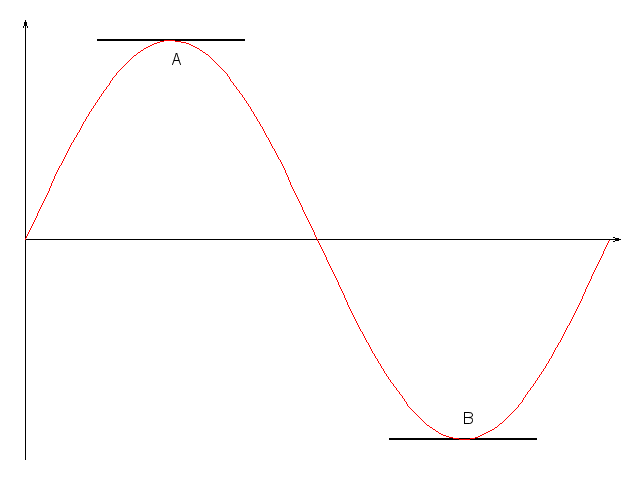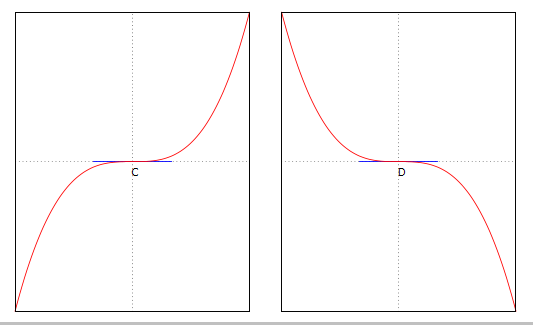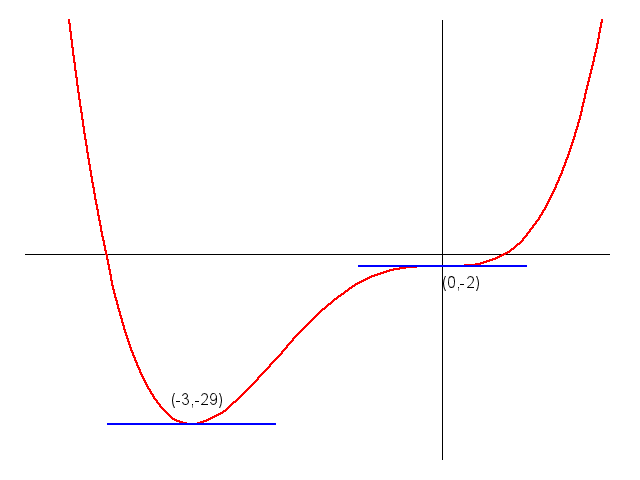Stationary Points
Definition
A stationary point of a function $f(x)$ is a point where the derivative of $f(x)$ is equal to 0. These points are called “stationary” because at these points the function is neither increasing nor decreasing. Graphically, this corresponds to points on the graph of $f(x)$ where the tangent to the curve is a horizontal line.
The stationary points of a function $y=f(x)$ are the solutions to
\[\cfrac{\mathrm{d}y}{\mathrm{d}x}=0.\]
This repeats in mathematical notation the definition given above: “points where the gradient of the function is zero”.
Classifying Stationary Points


A stationary point is called a turning point if the derivative changes sign (from positive to negative, or vice versa) at that point. There are two types of turning point:
- A local maximum, the largest value of the function in the local region.
- A local minimum, the smallest value of the function in the local region.
Note: all turning points are stationary points, but not all stationary points are turning points.
A point where the derivative of the function is zero but the derivative does not change sign is known as a point of inflection, or saddle point. These are sometimes referred to as rising or falling points of inflection, depending on whether the derivative of the function is positive or negative on either side of the stationary point.
Second Derivative Test
The second derivative test is used to determine whether a stationary point is a local maximum or minimum. A stationary point $x$ is classified based on whether the second derivative is positive, negative, or zero.
$\dfrac{\mathrm{d}^2 y}{\mathrm{d} x^2}$ |
Stationary point at $x$ |
|---|---|
$\gt 0$ |
Local minimum |
$\lt 0$ |
Local maximum |
$= 0$ |
Test is inconclusive |
If the test is inconclusive, we must use some other method to determine the nature of the stationary point (such as the first derivative test).
First Derivative Test
The first derivative test determines the nature of a stationary point $x$ by evaluating the sign of the first derivative at points $x+\epsilon$ and $x-\epsilon$, where $\epsilon\ll1\in\mathbb{R}$. This determines whether the function is increasing or decreasing at these points, thus indicating the shape of the graph.
Note:
- If $\dfrac{\mathrm{d}y}{\mathrm{d}x}>0$ at a point $x$ then the function is increasing at $x$.
- If $\dfrac{\mathrm{d}y}{\mathrm{d}x}<0$ at a point $x$ then the function is decreasing at $x$.
The following table shows the classification of a stationary point based on the first derivative test.
$\boldsymbol{x-\epsilon}$ |
$\boldsymbol{x}$ |
$\boldsymbol{x+\epsilon}$ |
Stationary Point |
|
|---|---|---|---|---|
$\boldsymbol{\dfrac{\mathrm{d}y}{\mathrm{d}x} }$ |
$>0$ |
$0$ |
$<0$ |
Local Maximum |
Shape of graph |
$\nearrow$ |
$\rightarrow$ |
$\searrow$ |
|
$\boldsymbol{\dfrac{\mathrm{d}y}{\mathrm{d}x} }$ |
$<0$ |
$0$ |
$>0$ |
Local Minimum |
Shape of graph |
$\searrow$ |
$\rightarrow$ |
$\nearrow$ |
|
$\boldsymbol{\dfrac{\mathrm{d}y}{\mathrm{d}x} }$ |
$>0$ |
$0$ |
$>0$ |
Rising inflection |
Shape of graph |
$\nearrow$ |
$\rightarrow$ |
$\nearrow$ |
|
$\boldsymbol{\dfrac{\mathrm{d}y}{\mathrm{d}x} }$ |
$<0$ |
$0$ |
$<0$ |
Falling inflection |
Shape of graph |
$\searrow$ |
$\rightarrow$ |
$\searrow$ |
First Derivative Test or Second Derivative Test?
When the second derivative is easy to calculate then it may be easier and faster to do the second derivative test rather than the first derivative test. However as we have seen, if the second derivative is zero at a stationary point then we don't know whether it is a maximum, minimum or a point of inflection. We would then have to do the first derivative test and so would end up doing more work.
Example 1
Find and classify the stationary points of the function $f(x)=x^4+4x^3-2$.
Solution

Finding the Stationary Points
Recall that the stationary points of a function $f(x)$ exist where the gradient of the function is zero, i.e. where $f'(x)=0$.
The derivative of the given function $f(x)=x^4+4x^3-2$ is:
\[f'(x)=4x^3+12x^2.\]
Stationary points exist where $f'(x)=0$, so for the given function the stationary points are the solutions to
\[4x^3+12x^2=0.\]
One way to find all solutions of this equation is to factorise $4x^3 + 12x^2$:
\[4x^3 + 12x^2 = 4x^2(x + 3).\]
The stationary points are therefore the solutions to:
\[4x^2(x+3) = 0.\]
One solution of this equation is $x^2=0$. Since $x^2=0\Rightarrow x=0$, there is a stationary point at $x=0.$
A solution also exists where $x+3=0$. Hence, there is another stationary point at $x=-3$.
The stationary points of the function $f(x)=x^4+4x^3-2$ are found at $x_1 = -3$ and $x_2 = 0$.
Determining the Nature of the Stationary Points
The second derivative test can be used to determine whether these points are a local maximum or minimum. To use this test, the second derivative $f''(x)$ must be calculated.
Note: It is often more convenient to use the unfactorised form of $f'(x)$ to find the second derivative.
The first derivative of $f(x)$ is:
\[f'(x)=4x^3 + 12x^2.\]
Differentiate this expression to find the second derivative:
\[f''(x)=12x^2+24x.\]
Recall that the second derivative test determines the nature of a stationary point $x=a$ by evaluating $f''(a)$. The point $x=a$ is a local minimum if $f''(a)>0$, or a local maximum if $f''(a)<0$.
At $x_1=-3$;
\begin{align} f''(-3)&= 12\cdot(-3)^2+24\cdot(-3) \\ &=12\cdot 9 -24\cdot3 \\ &=108-72 \\ &=36. \end{align}
Since $f''(-3)=36>0$ there is a local minimum at $x=-3.$
At $x_2=0$;
\begin{align} f''(0) &= 12\cdot(0)^2+24\cdot0 \\ &= 0. \end{align}
Here the second derivative test has failed. The first derivative test must be used to determine the nature of the stationary point at $x=0.$
Recall that the first derivative test determines the nature of a stationary point by examining the shape of the function in the nearby region.
Consider the point $x=-\epsilon$, where $\epsilon$ is positive and arbitrarily small. The first derivative evaluated at this point is:
\begin{align} f'(-\epsilon) &= 4\cdot(-\epsilon)^3+12\cdot (-\epsilon)^2 \\ &=-4 \epsilon^3 + 12 \epsilon^2 \end{align}
Since $\epsilon^3 \lt \epsilon^2$, $f'(-\epsilon)$ is positive, so the function is increasing on the left of $x=0$.
Now consider the point $x=\epsilon$. The first derivative evaluated at this point is:
\begin{align} f'(\epsilon) &= 4\cdot(\epsilon)^3+12\cdot(\epsilon)^2 \\ &= 4 \epsilon^3 + 12 \epsilon^2 \\ \end{align}
This is positive, so the function $f(x)$ is also increasing on the right of $x=0$.
The function $f(x)$ is increasing at points slightly to the left and slightly to the right of the point $x=0.$ This implies that the stationary point $x=0$ is a rising point of inflection.
- The stationary point found at $x=-3$ is a local minimum.
- The stationary point found at $x=0$ is a rising point of inflection.
Video Examples
Example 1
Prof. Robin Johnson finds and classifies stationary points of $f(x)=x^3-3x^2-1$.
Example 2
Prof. Robin Johnson finds and classifies stationary points of $f(x)=3x^4+4x^3-5$.
Example 3
Prof. Robin Johnson finds and classifies stationary points of $f(x)=40+(6x^3-56x)\sqrt{x}$.
Workbooks
These workbooks produced by HELM are good revision aids, containing key points for revision and many worked examples.
Test Yourself
Test yourself: Numbas test on finding maxima and minima
External Resources
- Applications of differentiation - maxima and minima workbook at mathcentre